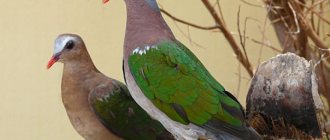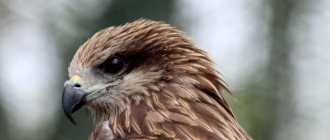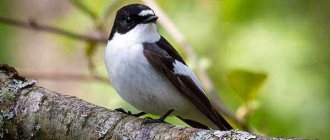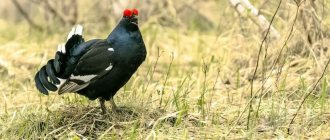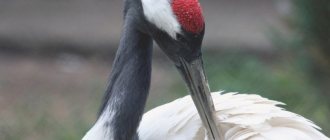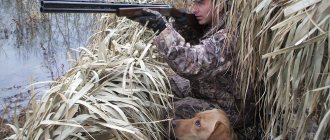| Latin name: | Aquila chrysaetos |
| English name: | To be confirmed |
| Kingdom: | Animals |
| Type: | Chordata |
| Class: | Birds |
| Squad: | Accipitridae |
| Family: | Accipitridae |
| Genus: | Eagles |
| Body length: | 76-93 cm |
| Wing length: | To be confirmed |
| Wingspan: | 180—240 cm |
| Weight: | 2800—6700 g |
Golden eagles have been used since ancient times in Central Asia for commercial hunting of foxes, hares, wolves and goitered gazelles. But over the past centuries, the golden eagle has disappeared from many areas of its habitat due to mass extermination of birds, the use of pesticides, urbanization and land conversion for economic needs.
Description, structure, characteristics
The golden eagle is a bird of prey, wild and very hardy, with a proud eagle-like posture, which is not surprising, because according to the zoological classification it belongs to the hawk family and the genus of eagles.
The average size of a golden eagle is 70-90 cm, with a wingspan of 180-250 cm. Interestingly, the female golden eagle is several times larger than the male. So the weight of a female reaches 7 kg, while male golden eagles weigh 3-5 kg.
The characteristic eagle's hook-shaped beak, with its sharp end curved down, is one of the iconic differences of this bird. The golden eagle also has slightly elongated feathers on the neck. In general, the golden eagle's body is strong and powerful, its wings are long and wide. In addition, young golden eagles are distinguished by a special bend in their wings; they are narrowed at the base and have an S-like shape. Therefore, it is not surprising that these birds are excellent flyers; the flight speed of a golden eagle in a diving flight can reach 320 km per hour.
The golden eagle's tail is somewhat longer and rounder at the end than that of other eagles, and in this way it is more similar to the tail of the golden eagle's relative -
hawks, however, unlike hawks' tails, the tails of golden eagles open wide like a fan during flight.
The golden eagle's eyes are dark brown, its beak is brown, and its legs are bright yellow.
The voice of golden eagles is somewhat reminiscent of the barking of a dog, but in general it is typical of eagles - ringing. In general, the golden eagle is a taciturn bird, calling only during the mating flight, communicating with chicks and defending its territory.
As for the color of this bird, adult golden eagles are usually brown or black-brown in color with golden feathers on the back of the head. At the same time, males and females have the same color, but it differs in young and older golden eagles, so young birds are almost black, but with pronounced white spots on the underside of the wings. With age and in the process of molting, young golden eagles gradually acquire a more “adult” color (with shades of brown and black), which is finally fixed by the age of 4-5 years.
Interesting fact: according to
ornithologists, white spots on the wings of young birds indicate their youth and, therefore, inexperience. They give them, a kind of indulgence, to hunt on someone else’s territory, belonging to one or another already adult golden eagle.
Interesting Facts
Zoologists tell some features of the life of predators:
- Golden eagles have some of the longest legs in the eagle family.
- In areas experiencing harsh winters, these birds migrate to warmer climates or simply fly from the mountains to the flatlands.
- The golden eagle has such acute vision that it is able to see a running hare from a height of 4 km.
- These birds are the fastest of the eagles and are capable of diving at speeds of 120 km/h.
- Birds can build nests both on the tops of trees and on rock ledges.
- Nests that are built annually can eventually reach enormous sizes.
- The female does not lay all the eggs at once, but with a break of several days.
- Already from infancy, the golden eagle shows its aggressive character: the older chick in most cases kills the younger one, especially if it is a female, while the parents do not enter into conflict and do not try to protect the weak one.
- When hunting a large prey, the predator plunges its claws deep into the body, delivering a fatal blow. Small game dies almost instantly.
- The young bird flies for the first time at the age of 70-80 days, preferring to remain close to the nest.
- The golden eagle's vision allows it to distinguish colors, which is rarely observed in the animal world.
- The egg-laying season is determined by the latitude of the predator's habitat. So, in the north of the hottest continent or in Mexico, chicks appear in January, in the cold northern regions and Alaska - in June, in the north of America - in March.
The feathered predator has been given the status of a species with minimal risk of extinction. But there are fines for hunting birds; if caught again, a prison sentence may be imposed.
The golden eagle in the photo and in real life looks majestic and graceful, so its vital activity and manners are of interest to specialists in the study of the animal world. To protect a species from a dramatic decline in population numbers, people should be diligent.
Nutrition
The golden eagle is a bird of prey and therefore its main diet is various small animals, usually various rodents: field mice, rats, gophers, ferrets, hares, martens, squirrels. Sometimes large golden eagles attack even such large animals as
foxes, fawns, calves and even sheep. They are not averse to feasting on other smaller birds, such as pigeons, ducks, herons, partridges, owls, and geese.
Interestingly, the daily food requirement of a golden eagle is 1.5 kg of meat. In this case, he can fast for up to 5 weeks.
The story of life at the zoo
In the collection of the Moscow Zoo, a pair of golden eagles currently lives in a separate enclosure on the Old Territory next to the Giraffe House, on the one hand, and the “Cats of the Tropics” pavilion, on the other. Since the enclosure is separate, zoo staff have hope that this couple can give birth to offspring in the near future. Unfortunately, the last case of golden eagles breeding (in a nursery) was back in 2001. However, in the 1990s, when each pair of golden eagles lived in a separate enclosure, cases of these eagles breeding were noted more than once (in 1994 and 1995). Indeed, it is impossible to imagine that such a strictly territorial species as the golden eagle could nest in the living conditions of a “communal apartment.”
One old female lives in a shared enclosure with other eagles in the New Territory.
The daily diet of golden eagles at the zoo includes 600 g of meat and 1 rat.
Hunting
The hunting pattern of the golden eagle depends on weather conditions. So, in clear weather, the golden eagle will soar in the heights, looking for prey with its keen gaze, and when one appears in its field of vision, the golden eagle quickly dives, grabs the victim with its tenacious claws, breaks the spine or hits with its sharp beak, tearing blood vessels, and carries the already dead one into your nest. In cloudy weather, the golden eagle will wait for its prey in ambush sitting on the treetops. And again, when suitable prey appears nearby, he acts according to the same algorithm - a rapid throw, grabbing, and so on...
Features of character and lifestyle
Photo: Golden eagle bird
The golden eagle prefers to avoid areas that are located near human settlements. Although in ancient times people tamed these huge predators. Golden eagles tend to form pairs and build nests. To build a nest, you need a tall tree. Most often it is pine or aspen. Birds are considered monogamous. They choose a mate and most often exist in this pair throughout their lives.
They tend to create several nests, from one to five, and live in them alternately. The distance between nests is 13-20 kilometers. In the habitat of one pair, other young individuals who have not yet formed a pair can live peacefully. Feathered predators calmly perceive such a neighborhood. A specific area is chosen for hunting. In winter, when the amount of food is sharply reduced, golden eagles increase their hunting territory.
Birds are very afraid of human interference in their natural habitat. If a person discovers their nest containing eggs, golden eagles most often abandon it. Birds have incredible tenacity and strength. They will continue to follow the victim until it becomes their prey. Predators are endowed with enormous strength. One adult bird can lift a load weighing up to 25 kilograms into the air. The strength of the lower limbs allows large specimens of an adult wolf to bend their necks. Birds are characterized by endurance, the ability to hunt in pairs, as well as a fighting spirit.
Despite their size, feathered predators tend to fly very gracefully, soar easily in the air and radically and quickly change their flight path. The bird goes hunting only during daylight hours, when the air reaches a certain temperature and it is comfortable for it to soar in the air. Birds tend to develop a specific route along which golden eagles fly around their properties in search of food. They also tend to choose guard trees, which offer an excellent overview of a large area. The areas where birds hunt vary in size. Their size ranges from 140 to 230 square meters. km. It is uncharacteristic for golden eagles to vocalize; you can only occasionally hear any sounds from them.
Types, photos and names
There are 6 main subspecies of golden eagles, which differ in feather color and size; below are some of them.
Canadian golden eagle
Lives in North America, USA and Canada.
Central Asian golden eagle
This golden eagle, which lives in the mountains of central Asia, is distinguished by its distinct dark feather color and black “cap”. The feathers on the back of his head are brown, not golden.
Southern European golden eagle
This subspecies of golden eagle lives in the mountains of Southern Europe from Spain to the Caucasus. Found also in our Carpathians. Its color is slightly lighter than that of other golden eagles, and it has a clearly visible “cap” on its head.
Population of the species
is included in the Red Book because it is considered a rare species of birds. However, according to modern data, the number of individuals is not decreasing; in recent years, there has even been an increase in populations. Human activity is the only thing that affects the lives of these animals.
In the 18th-19th centuries, birds were shot because they caused damage to livestock. Thus, almost all representatives of this species were destroyed on German territory. In the last century, the decline in numbers was facilitated by the widespread use of aggressive chemicals.
Since birds feed on living creatures, harmful chemical compounds entered the bird’s body along with them, resulting in pathologies in the development of embryos and, as a consequence, the death of the young.
Nowadays, people are actively populating territories, which limits the choice of habitat not only for eagles, but also for small rodents that are prey for predators. All this may lead to a decline in bird numbers.
To help restore the golden eagle population and protect it from extinction, all necessary measures are being taken in many countries where the habitat is being invaded. Thus, in the vast expanses of Russia and Kazakhstan, eagle nesting sites are classified as protected areas and are subject to protection.
By the way, on our territory alone the golden eagle lives in more than 20 such protected areas. Birds can be found in private lands and zoos, but in such conditions they breed extremely rarely.
Reproduction of golden eagles
Golden eagles are monogamous birds; they remain marital fidelity throughout their lives, as long as their mating partner is alive. It is interesting that each pair of golden eagles usually has 2-4 nests in different places, where they alternately fly at different times of the year.
The mating season for golden eagles occurs from February to April, at which time males make special demonstrative flights in front of females: wanting to impress their chosen one, they perform various aerial aerobatic maneuvers. This could be, for example, a wave-like flight, when the golden eagle first gains altitude and then rapidly dives down, at the lowest point gaining altitude again and so on in a circle.
The female lays eggs in mid-April, with approximately 1-3 eggs in one clutch. The male and female incubate them alternately for 45 days. Then the chicks are born, while they are little, the mother feeds them, and the father brings prey. Little golden eagle chicks develop and grow very quickly, and after about six months they separate from their parents.
Golden eagle: origin of the name of the bird
The ancient Russian word “eagle” in other languages of the Slavic peoples is close to the ancient Germanic Aar or Aro (Scandinavian Orn, Scottish Erne).
Russian writers of the 18th century in their works applied the names “stone” and “golden” eagle to this strong and majestic bird (for example, V. Levshin), perhaps, according to the German expressions Stein-adler, Goldadler.
The name “Kama eagle,” also according to Levshin, is explained by the fact that the Bashkirs caught these birds from nests on the Kama River for subsequent sale in the steppes of Kyrgyzstan. Also, many Russian authors used two names for eagles: khalzan and golden eagle. The second word was used to call young birds, and khalzans - to older birds.
The word "golden eagle" (burkut and byurkut) has Turkic roots. These birds are popular and widespread in Central Asia. There they are used for hunting.
Captivity
Since ancient times, people have tamed this bird of prey as an assistant in hunting. And although keeping golden eagles in captivity is not a simple matter, nevertheless, an unforgettable hunt with their participation compensates for the trouble. Young birds are usually chosen for training, gradually taming them. So the hunter puts on a leather glove, puts the golden eagle on it and rides around the city with it, this is done so that the bird gets used to the voice and sight of people.
At the same time, the golden eagle is limited in food; it is fed every other day, while at the same time poisoning it against a stuffed animal.
Social structure and reproduction
Photo: Golden eagle in flight
Golden eagles are monogamous by nature. Loyalty and devotion to the chosen couple remains throughout life. The choice of the second half occurs at the age of three years. The mating season begins at the end of February and lasts almost until the end of April. The mating games of birds look very impressive. It is common for both male and female individuals to demonstrate their beauty, strength and power. This manifests itself in spectacular flights. Birds gain greater altitude. Then they dive sharply down and spread their huge wings just before the surface of the earth. They also tend to show off their hunting capabilities. They extend their claws and simulate chasing and capturing prey.
After the birds have chosen a mate, they begin to build nests and lay eggs. They are very careful when choosing a place to build a nest. Usually this is a secluded place in the canopy of trees at a high altitude. The height of one nest reaches 1.5-2 meters, and the width is 2.5-3 meters. It is built from branches and twigs, the bottom is lined with soft leaves and moss. Each nest contains from one to three eggs. They are grayish-white in color with black spots. It takes one and a half months to hatch the eggs. Sometimes the male replaces the female, but this is rare.
The chicks hatch from the eggs one at a time. The older chicks are always larger and stronger, and will push the younger and weaker ones away from the food that the male gets. At the same time, parents do not try to restore justice. As a result, the weaker chick dies from starvation. The chicks spend almost three months in the nest. After this, the mother teaches them to fly. Communication with chicks is one of the few reasons for birds to vocalize. Chicks that have mastered flight skills remain in the nest until next spring. Life expectancy in natural conditions is about 20 years. In captivity, this figure can double.
Video
And in conclusion, we invite you to listen to what a golden eagle sounds like.
Author: Pavel Chaika, editor-in-chief of Poznavaika magazine
When writing the article, I tried to make it as interesting, useful and high-quality as possible. I would be grateful for any feedback and constructive criticism in the form of comments on the article. You can also write your wish/question/suggestion to my email [email protected] or Facebook, with respect, the author.
Author page
This article is available in English -
Golden Eagle.
Golden eagle attacks. Video (00:01:00)
The golden eagle was filmed in Montreal - it is one of the most famous birds of prey of the hawk family, the largest eagle. Distributed in the northern hemisphere, where it lives mainly in the mountains, and to a lesser extent in flat open and semi-open landscapes. Avoids residential areas and is sensitive to human disturbance. In most of the range they live sedentary, keeping in pairs near the nest; on the northern periphery of the distribution area and highlands, some birds migrate to less snowy areas. Hunts a wide variety of game, most often hares, rodents and many species of birds. Sometimes attacks sheep, calves and baby deer. The nest is made in a tree or on a hard-to-reach rocky ledge. There are usually two eggs in a clutch, but most often only one chick survives. In Central Asia, the golden eagle is used for commercial hunting of foxes, hares, and sometimes wolves and goitered gazelles.
Hunting golden eagle (1996, Russia). Video (01:01:17)
The authors of this rare and wonderful film will tell viewers about a unique bird named “Altai” and its owner Yuri Noskov. Altai may be the only golden eagle in the world that hunts “freestyle”. In the Siberian taiga, Yuri Noskov releases a hunting bird to fly, and it itself finds the game and catches it. Nowhere else in the world do golden eagles hunt like this.
Russia, 1996 (published on DVD in 2006) Director: Andrey Sedov Text read by: Vasily Peskov
Source: Own DVD



